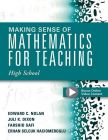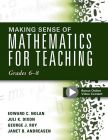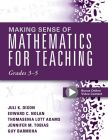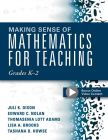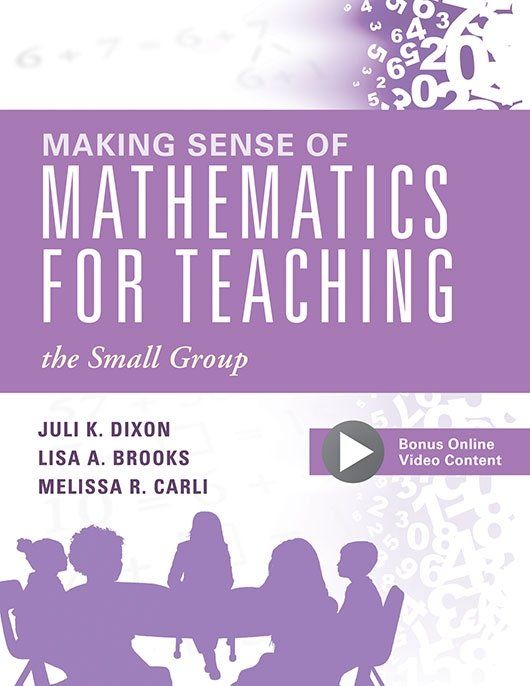
Making Sense of Mathematics for Teaching the Small Group
Make sense of effective characteristics of K–5 small-group instruction in mathematics. Connect new understandings to classroom practice through the use of authentic classroom video of pulled small groups in action. Use the TQE (Tasks, Questions, Evidence) process to plan time effectively for small-group instruction.
Experience the convenience of eBooks! Access your eBooks anytime, anywhere on any desktop, Android, or iOS device through VitalSource. eBook purchases are limited to one eBook per title, per account. Please visit our FAQ for more information.
Small-group instruction strategies to differentiate math lessons in elementary classrooms
When done right, small-group instruction is a powerful tool for facilitating student understanding in K–5 mathematics. Throughout the book, best practices for small-group math instruction are addressed in detail, from planning tasks that encourage deep understanding to asking effective questions to engaging learners in meaningful conversations. Readers will learn how teaching mathematics in small groups allows you to differentiate instruction for both remediation and enrichment. The included small-group instruction videos demonstrate the suggested strategies in a real-classroom setting, giving readers the opportunity to see best practice in action.
Develop math-specific instruction strategies for teaching small groups in elementary school:
- Explore the benefits of small-group math instruction and how it can facilitate deep mathematical understandings.
- Discover the teacher’s and students’ roles in small-group instruction and how teachers can help students develop the skills to fulfill their role.
- Learn how to apply the Tasks, Questions, and Evidence (TQE) process to small-group instruction in order to enhance student learning and improve your knowledge of teaching mathematics.
- View examples of small-group instruction and how the structure can support differentiation.
Related Topics
Additional Information
“Whether you’ve been teaching in small groups for years or are looking for structures to help you get started, Making Sense of Mathematics for Teaching the Small Group has ideas and tools to help you improve instruction. The authors provide thoughtful examples, including what teachers and students should be doing while working in small groups, ideas on how to support students without doing the thinking for them (via a comparison of just-in-case scaffolding and just-in-time scaffolding), and even instruction on how to set up a group’s norm so that more time is spent discussing the tasks at hand. This book is a great companion for all mathematics teachers looking to facilitate small-group instruction.”
“Leading effective small groups is both important and challenging work for teachers. How, when, and why do we lead small-group instruction so that students experience themselves as capable and confident mathematicians? Juli K. Dixon, Lisa A. Brooks, and Melissa R. Carli have written a book that will give readers tools, resources, and practical guidelines for making the most of small-group instruction. Their vivid examples bring these ideas to life and will help you grow your practice in powerful ways.”
“This book addresses a huge need in elementary math classrooms! It shows teachers clear and effective strategies to continue to use small-group instruction but in a more effective way that will benefit student learning of mathematics. It would be easy to implement a book study with a group of teachers since the videos are so engaging and would elicit wonderful teacher discussions. The quantity and variety of videos make the use of best practices come alive for teachers and provide clear models for instructional improvement.”
When can I access my eBook? Your eBook will be accessible through VitalSource once your payment has been processed.*
*When using a check or purchase order, the order submitted online will not be processed until Solution Tree receives the check or a copy of the signed official purchase order. Your purchase order must note payment terms of net 30 days. We cannot process purchase orders that do not note these payment terms. Please submit all payments to [email protected].
How do I access my eBook?
To access your eBook:
- Create a free VitalSource account by visiting VitalSource.com. If you already have a VitalSource account, please log in to your account.
- Paste the redemption code that Solution Tree will email you in the “Redemption Code” field on VitalSource.com/Redeem. (Note: You can also access your redemption code within your Solution Tree account under the “eBook” section.)
- Click “Redeem.”
- Enjoy! Once your code is redeemed, your book will be added to your VitalSource Bookshelf and can be read anytime, anywhere.
What are the technical requirements for accessing the eBook? A VitalSource account is required. To sign up for your free account, please visit VitalSource.com.
What if I have trouble accessing my eBook? Please contact VitalSource by emailing [email protected] or by utilizing their Live Chat feature.
What are the shipping and handling costs? There are no shipping or handling costs associated with eBooks. For paperback and hardcover book purchases, standard shipping costs apply. Please visit the Product Orders page for more information on shipping and handling costs.
Can I purchase multiple copies of the same eBook? Bulk orders are not currently available through the website. Website purchases are limited to one eBook per title, per account. If you want to order multiple copies of an eBook, please contact customer support at [email protected].
What if I need to request a refund on my eBook order? RETURN POLICY: We are unable to accept returns or cancel previously placed eBook orders.

